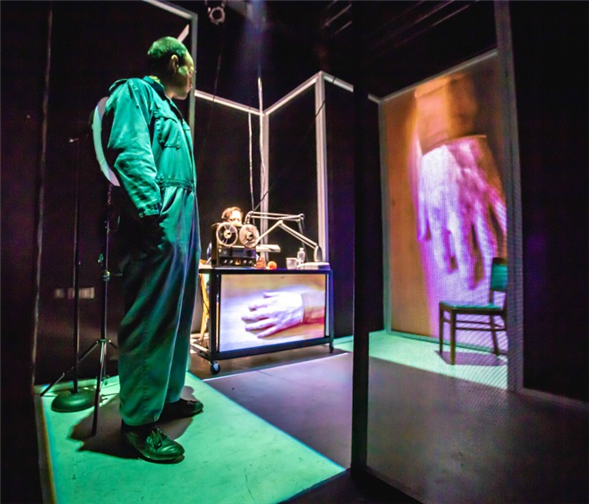Translate Page

Theater Mitu's new show explores war and death from many angles
---
How do you create a multimedia meditation on war, death and loss by artistic consensus? That's what Brooklyn-based company Theater Mitu set out to do with Remnant, the inaugural production in the troupe's new Gowanus home. Crafted out of extensive interviews and research conducted by 11 members of the collective, the immersive experimental show is ambitious in theme, design and execution.
Remnant is organized into three simultaneously staged 25-minute vignettes that can be viewed from any starting point. To help audiences focus on the scene at hand, all the audio is piped through headphones, which heightens the intimacy of the experience, a fusion of theatre, music, technology and even art installation.
Despite the challenges inherent in the show's format, getting everyone to agree on what material would make the cut was the biggest hurdle in Remnant's three-year development process. Initially, each artist worked independently, delving into the heady topics and sharing work with their collaborators. If the entire company was moved by a presentation, the piece stayed -- at least until the next round of distillation. "Moved can mean tears, it can mean chills, it can mean laughter," says Rubén Polendo, the founding artistic director of Theater Mitu who also helms Remnant. "We may very well at times sit there and go, 'I don't even know why this makes me want to cry, but there's something about it.'"
The members of Theater Mitu consider themselves a family and, like most kin, they can be hard on each other, which inevitably led to disputes over what should be included. "The generating of the ultimate work is not a space of compromise," Polendo says. "We could do 15 versions of this production with how much material we have on the cutting-room floor, but we have to be ruthless so the stuff that sticks around really makes an impact on all of us as a company. We function as representatives of the first audience witnessing this work."
The unique structure of Remnant actually came out of a debate. For months, the artists deliberated over how to present the show. Was it a linear narrative or a triptych? In what order should the three pieces be presented? "We sat in complete disagreement as a company," Polendo recalls. "We often stage the agreement, but how can we stage the disagreement? How can we actually stage the company's tension? That became really exciting because it reflects our creation process."
Theater Mitu was able to work through that stalemate in large part due to the flexibility of its new venue, MITU580, a former glass recycling facility transformed into a 2,400-square-foot black box. "Now there are no rehearsal markers," Polendo says. "We're crafting this in the space, so we slowly get to evolve it. It's a great privilege as artists not to have to tape the floor for a rehearsal. We're literally building the structures and realizing that's how it should be."
As they worked through their options, they decided mounting the three segments at the same time made the most sense since the show, like the company, thrives on multiplicity. Theater Mitu's name alone has six different meanings, and Remnant is open to interpretation. But Polendo thinks the wildly different reactions the show inspires is a testament to its success. "An invitation to connect is a much richer one if there is a certain amount of variance in it," says Polendo. "Much of the work of the performance happens after the show. I love hearing people in the lobby share their trajectory with other people. We all experienced the same thing. How can it be so different?"
---
Jen Gushue is a freelance theatre writer with bylines in American Theatre, HowlRound and Business Insider. Follow her on Twitter at @jengushue. Follow TDF at @TDFNYC.
Top image: Corey Sullivan and Michael Littig in Remnant. Photos courtesy of Theater Mitu.
TDF MEMBERS: Go here to browse our latest discounts for dance, theatre and concerts.